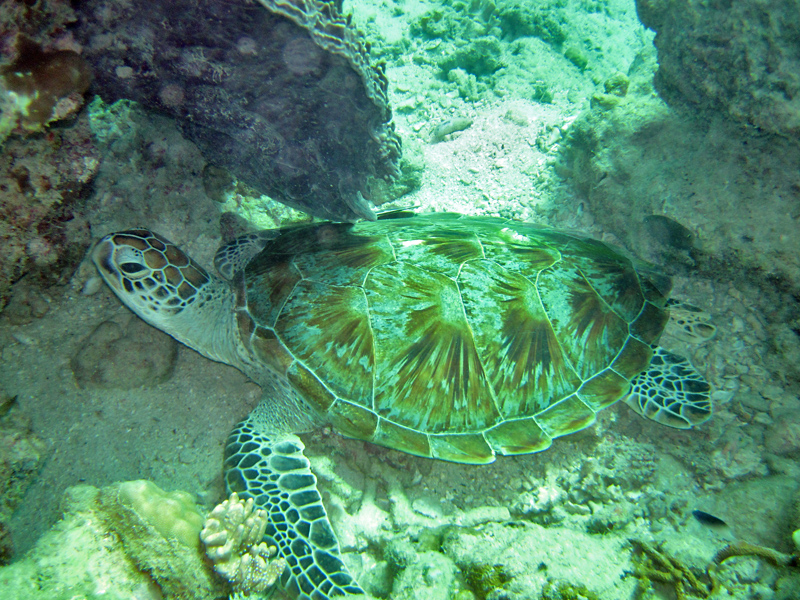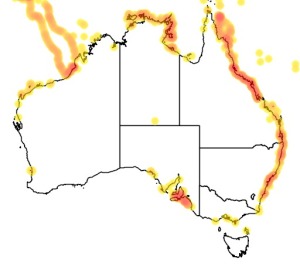Colours
Distinguishing features
It has a dorsoventrally flattened body, a beaked head at the end of a short neck, and paddle-like arms well-adapted for swimming.
Anatomically, a few characteristics distinguish the green turtle from the other members of its family. Unlike the closely related hawksbill turtle, the green turtle's snout is very short and its beak is unhooked.
The sheath of the turtle's upper jaw possesses a denticulated edge, while its lower jaw has stronger, serrated, more defined denticulation. The dorsal surface of the turtle's head has a single pair of prefrontal scales.
Its carapace is composed of five central scutes flanked by four pairs of lateral scutes. Underneath, the green turtle has four pairs of inframarginal scutes covering the area between the turtle's plastron and its shell.
On mature specimens, the front flippers have only a single claw (as opposed to the hawksbill's two), although a second claw is sometimes prominent in young specimens. (Wikipedia)
Size
- Up to 150 cm (Total Length)
- Up to 112 cm (Carapace Length)
Synonyms
Similar taxa
- Animalia: Hawksbill turtle (species: Eretmochelys imbricata)
-
Animalia:
Hawksbill turtle (species: Eretmochelys imbricata)
has a distinctive beak-like snout and two pairs of plates on top of the head between the snout and the unpaired central plate.
Comments
They nest on Normanby Island. Guardian: Rob Toomey
by David Witherall
Distribution
Distribution and habitat preferences
Their range extends throughout tropical and subtropical oceans worldwide.
Green sea turtles move across three habitat types, depending on their life stage. They lay eggs on beaches. Mature turtles spend most of their time in shallow, coastal waters with lush seagrass beds. Adults frequent inshore bays, lagoons and shoals with lush seagrass meadows. Entire generations often migrate between one pair of feeding and nesting areas.
Young turtles spend most of their first five years in convergence zones within the open ocean. These young turtles are rarely seen as they swim in deep, pelagic waters. (Wikipedia)
Local abundance
- South-West Western Australian beaches: Almost all records in this area including southern Perth beaches are derelict, dead or moribund hatchlings swept from northern breeding sites by the Leeuwin Current. They sucumb when they get into colder water. Adults have been reported offshore (Rottnest Island) in recent years.
Behaviour
Green Turtles nest infrequently at Lizard Island. Some years, no nests at all are seen. In other years, tens of nests may be ������seen on beaches around the island. Nesting ������mostly occurs in November or December but attempts ������have been seen as late as March. ������Hatchings ������were ������observed at Lizard Island ������in March ������(early 1990s) and ������on 27 ������May 2006. ������
Web resources
References
- Goatley, C.H.R. (2013). The ecological role of sediments on coral reefs, PhD thesis, James Cook University. LIRS catalog number 1840.
- Goatley, C.H.R., A.S. Hoey and D.R. Bellwood (2012). The role of turtles as coral reef macroherbivores. PLoS One, 7(6): e39979. LIRS catalog number 1523.
- Limpus, C.H. (1982). The reptiles of Lizard Island, Herpetofauna, 13(2): 1-6. LIRS catalog number 73.
- View all references

















